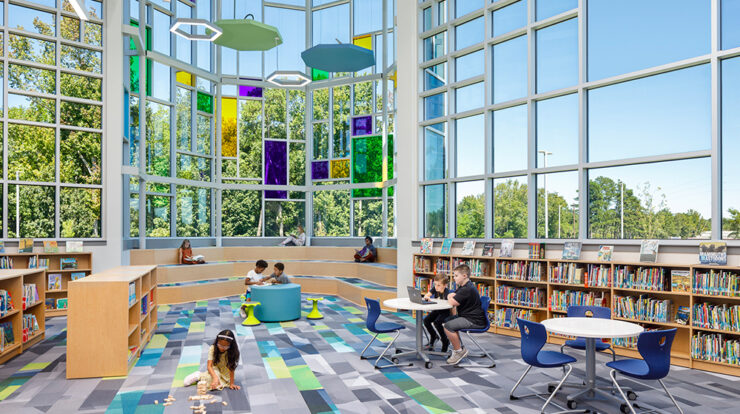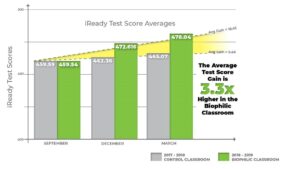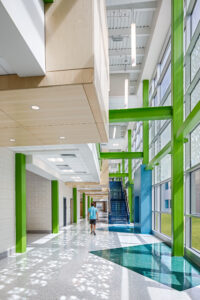

Features
Architecture Issue Addresses Outcomes of Biophilic Design for Schools
Bill Browning
Share
A special issue of Architecture entitled, “Biophilic School Design for Health and Wellbeing”, Terrapin’s Bill Browning teamed up with Jim Determan of Craig Gaulden Davis Architecture to explore the results from the yearlong study of biophilic measures in a sixth grade mathematics classroom in Baltimore. Those results influenced the design of the new Bethel-Hanberry elementary school in South Carolina, and the paper includes outcomes for students and faculty in this new school.

Chart showing difference in student test performance outcomes in biophilic classroom compared to control (non-biophilic) classroom. Figure courtesy Craig Gaulden Davis Architects
The Baltimore study at the Green Street Academy documented improved learning outcomes measured over the course of the year. The study also included biometric testing of stress recovery characteristics, and found that the students had better stress recovery measurements at the end of a class period than at the beginning. That outcome is also reflected in interviews and surveys where the student expressed that being in the biophilic classroom made them feel calmer.
The Bethel-Hanberry School design, like the Baltimore classroom, features patterns of Visual Connection with Nature, Dynamic Light, and the incorporation of Complexity & Order through statistical fractal patterns on hallway window fritting. Spatial patterns include Prospect and Awe.

Young student walking down a dappled, daylit corridor at Bethel-Hanberry School. Photo by Kristopher Decker/Firewater Photography
A team from the University of South Carolina Upstate conducted a yearlong study of outcomes for students and faculty. The Bethel-Hanberry school replaced an existing school so the researchers were able to compare outcomes against the data from the prior school. They found a significant drop in chronic absenteeism and improved learning reflected in MAP scores.
To learn more about the details of the design interventions, study methods and results, read the full article by Browning and Determan in Architecture/MDPI: https://www.mdpi.com/2673-8945/4/3/26.
Also in this special issue of Architecture are seven other articles on biophilia in learning environments, including a few articles by several Terrapin colleagues. The topics include, among others,
- Designing Thriving School Ecosystems: The Synergy of Biophilic Design, Wellbeing Science, and Systems Science, by Fiona Gray andAndrea Downie
-
A Toolkit of Biophilic Interventions for Existing Schools to Enhance Student and Faculty Health and Performance, by Kari Leif and Vivian Loftness
-
The ‘Nature’ of Vertical School Design—An Evolving Concept, by Alan J. Duffy
Article Reference: Browning, W. & Determan, J. (2024). Outcomes of Biophilic Design for Schools. Architecture 2024, 4(3), 479-492; https://doi.org/10.3390/architecture4030026
Topics
- Environmental Values
- Speaking
- LEED
- Terrapin Team
- Phoebe
- Community Development
- Greenbuild
- Technology
- Biophilic Design Interactive
- Catie Ryan
- Spanish
- Hebrew
- French
- Portuguese
- Publications
- Occupant Comfort
- Materials Science
- Conference
- Psychoacoustics
- Education
- Workshop
- Mass Timber
- Transit
- Carbon Strategy
- connection with natural materials
- interior design
- inspirational hero
- biophilia
- economics of biophilia
- Sustainability
- wood
- case studies
- Systems Integration
- Biophilic Design
- Commercial
- Net Zero
- Resorts & Hospitality
- Energy Utilization
- Water Management
- Corporations and Institutions
- Institutional
- Ecosystem Science
- Green Guidelines
- Profitability
- Climate Resiliency
- Health & Wellbeing
- Indoor Environmental Quality
- Building Performance
- Bioinspired Innovation
- Biodiversity
- Residential
- Master Planning
- Architects and Designers
- Developers and Building Owners
- Governments and NGOs
- Urban Design
- Product Development
- Original Research
- Manufacturing
- Industrial Ecology
- Resource Management
- Sustainability Plans
- Health Care
- Carbon Neutrality


